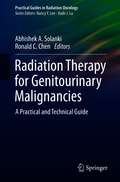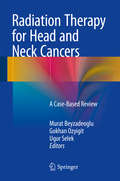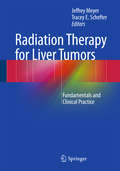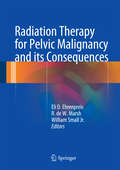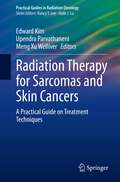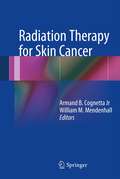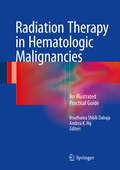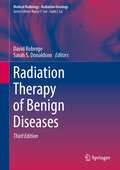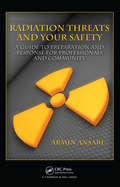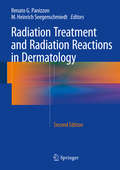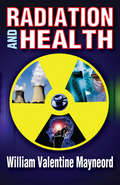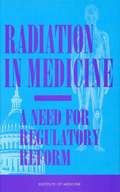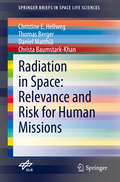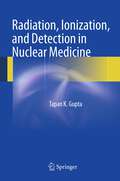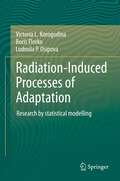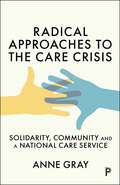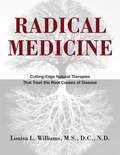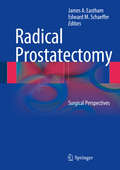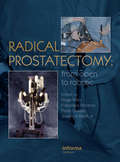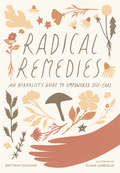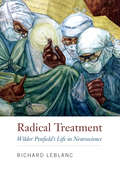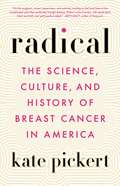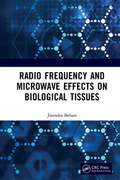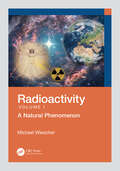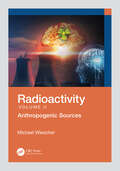- Table View
- List View
Radiation Therapy for Genitourinary Malignancies: A Practical and Technical Guide (Practical Guides in Radiation Oncology)
by Abhishek A. Solanki Ronald C. ChenThis book is a comprehensive guide to the use of modern radiation therapy techniques for prostate cancer and other common and rare genitourinary malignancies. It will be an ideal resource for clinicians and trainees wishing to delve more deeply into the practical and technical aspects of radiotherapy for these malignancies and will serve to enhance day-to-day management in clinical practice. The first section is devoted to prostate cancer and includes coverage of low dose rate and high dose rate brachytherapy, conventionally fractionated, moderately hypofractionated, and ultra-hypofractionated external beam radiotherapy, and proton therapy. The second section focuses on radiotherapy considerations in relation to bladder cancer, testicular cancer, renal cell carcinoma, and rare malignancies such as penile cancer and urethral cancer. Radiotherapeutic treatment of patients with genitourinary malignancies now involves unprecedented precision and complexity, and this book will enable readers to exploit fully the exciting advances that have been achieved in recent years.
Radiation Therapy for Head and Neck Cancers
by Gokhan Ozyigit Murat Beyzadeoglu Ugur SelekThis evidence-based guide to the current management of cancer cases at all head and neck sites will assist in the appropriate selection and delineation of tumor volumes/fields for intensity-modulated radiation therapy (IMRT), including volumetric modulated arc therapy (VMAT). Each tumor site-related chapter presents, from the perspective of an academic expert, several actual cases at different stages in order to clarify specific clinical concepts. The coverage includes case presentation, a case-related literature review, patient preparation, simulation, contouring, treatment planning, treatment delivery, and follow-up. The text is accompanied by illustrations ranging from slice-by-slice delineations on planning CT images to finalized plan evaluations based on detailed acceptance criteria. The book will be of value for residents, fellows, practicing radiation oncologists, and medical physicists interested in clinical radiation oncology
Radiation Therapy for Liver Tumors
by Jeffrey Meyer Tracey SchefterThe management of liver tumors is a nexus of interactions among multiple medical specialties, including radiation oncology. A multitude of liver-directed therapies are available for patients, ranging from surgery and liver transplantation to intra-arterial therapies, thermal ablation procedures, systemic therapies, and radiation treatments. With the introduction of hypofractionated irradiation, particle therapy, and radioembolization, there is growing interest in the use of radiation as a treatment for liver malignancies. This book examines basic principles of the management of liver tumors. The evolving roles of x-ray and particle therapies as well as radioembolization in the treatment of liver tumors is the main focus. A theme of multidisciplinary management is also emphasized, as surgical, interventional and systemic therapies are reviewed. A unique resource that discusses the role of radiation treatment in the context of other liver-directed therapies, Radiation Therapy for Liver Tumors is of broad interest to radiation oncologists, surgeons, hepatologists, medical oncologists, and radiologists.
Radiation Therapy for Pelvic Malignancy and its Consequences
by Eli Daniel Ehrenpreis R de W Marsh William Small Jr.This book provides a state-of-the-art review of the role of radiation therapy in various pelvic malignancies as well as the consequences of the radiation in the pelvic tissues. With sections covering the role of radiation therapy in the various pelvic malignancies, the pathophysiology of radiation related injury and the risk factors that increase the possibility of such an injury, and the latest in medical, endoscopic and surgical therapies for these radiation related complications the text offers a concise yet comprehensive overview of radiation therapy in the human pelvis, its role and the adverse effects on the pelvic organs. Written by experts in the field with readers in mind, Radiation Therapy for Pelvic Malignancy and its Consequences is the first of its kind standalone reference on the subject. Radiation Therapy for Pelvic Malignancy and its Consequences is of great value to urologists, medical radiation and gynecological oncologists, and gastroenterologists.
Radiation Therapy for Sarcomas and Skin Cancers: A Practical Guide on Treatment Techniques (Practical Guides in Radiation Oncology)
by Edward Kim Upendra Parvathaneni Meng Xu WelliverThis practical guide to the use of radiotherapy for the treatment of sarcomas and skin cancers covers a wide range of disease scenarios, identifying which treatment techniques are applicable in particular clinical circumstances. Among the conditions considered are extremity soft tissue sarcomas, retroperitoneal soft tissue sarcomas, bone sarcomas, uterine sarcomas, chordomas, pediatric sarcomas, squamous cell carcinomas, basal cell carcinomas, melanomas, Merkel cell carcinomas, and cutaneous lymphomas. Detailed attention is devoted to the issues and considerations of relevance in everyday practice when treating these diseases. The use of multiple radiotherapy techniques and procedures, including IMRT, brachytherapy, radiosurgery, and particle therapy, is fully explained, and the role of radiotherapy in combination with chemotherapy and emerging therapeutics such as immunotherapy and biologic anticancer agents is also addressed. The book will be of high value for practicing radiation oncologists, medical and surgical oncologists, medical physicists, medical dosimetrists, trainees, and other medical professionals.
Radiation Therapy for Skin Cancer
by William M. Mendenhall Armand B. Cognetta Jr.Photon Radiation Therapy for Skin Malignancies is a vital resource for dermatologists interested in radiation therapy, including the physics and biology behind treatment of skin cancers, as well as useful and pragmatic formulas and algorithms for evaluating and treating them. Dermatology has always been a field that overlaps multiple medical specialties and this book is no exception, with its focus on both dermatologists and radiation oncologists. It is estimated that between 2010 and 2020, the demand for radiation therapy will exceed the number of radiation oncologists practicing in the U.S. tenfold, which could profoundly affect the ability to provide patients with sufficient access to treatment. Photon Radiation Therapy for Skin Malignancies enhances the knowledge of dermatologists and radiation oncologists and presents them with the most up-to-date information regarding detection, delineation and depth determination of skin cancers, and appropriate biopsy techniques. In addition, the book also addresses radiation therapy of the skin and the skin's reactions to radiation therapy.
Radiation Therapy in Hematologic Malignancies
by Bouthaina Shbib Dabaja Andrea K. NgThis book is designed to assist practitioners in managing patients who present with difficult cases of the most common hematological malignancies. The scenarios covered are those that are likely to be encountered in patients with the various forms of Hodgkin's lymphoma, non-Hodgkin's lymphoma, and leukemia. In each of the three sections devoted to these malignancies, multiple cases are presented. The case discussions follow a standard format. A clinical description is followed by a pathological description documenting information relevant to diagnosis and by details of staging work-up, including images. The treatment options are then discussed at length, highlighting relevant literature for each option. Finally, the treatment delivered is identified and images of the planning technique/modality used are provided. This book will be an invaluable aid to decision making for radiation oncologists and will also be of interest for hematologists.
Radiation Therapy of Benign Diseases (Medical Radiology)
by Sarah S. Donaldson David RobergeThis expanded and updated second edition is a practical text to aid radiation oncologists in evaluating and treating benign diseases. An introductory chapter by an eminent malpractice lawyer clarifies the medical-legal implications of the radiation treatment of such diseases, and this is followed by the various benign conditions in alphabetical order. In each case, a brief summary is followed by citations of pertinent literature in both explanatory tables and reference lists. Although a comprehensive review, it remains readily comprehensible and will be recognised as the standard text on the subject.
Radiation Threats and Your Safety: A Guide to Preparation and Response for Professionals and Community
by Armin AnsariWhile it has aided far many more than it has harmed, radiation is forever etched in the public's mind as an indiscriminate and particularly pernicious killer. Consequently, it is especially critical in this age of terrorist threats that we equip ourselves with accurate information and practical tools that will serve us in the rare chance that we find ourselves in a radiation crisis.Radiation Threats and Your Safety: A Guide to Preparation and Response for Professionals and Community offers a calm and authoritative approach to crisis preparation. Written by a health physicist from the U.S. Centers for Disease Control and Prevention, the book informs us about what we should know ahead of time, how to prepare, and the best ways to respond to a nuclear or radiological incident either as an emergency responder or community/family member. Organized to serve both as a preparation guide and as a reference in a crisis, this book -Uses common language while avoiding unnecessary scientific jargon -Details protocols for both accidental and intentional radiation emergencies such as nuclear explosions and dirty bombs-Shows how to prepare a family emergency plan-Covers medical responses to radiation emergencies including radiation drugs -Provides an emergency supply list -Discusses radiation from microwaves and cellular phones as well as food irradiation There is no reason why we should feel helpless when faced with a radiation emergency. We can take action to protect ourselves, our families, and our communities. How we react to a radiation emergency will determine its true final impact. To this end, we need information and leaders we can depend upon.
Radiation Treatment and Radiation Reactions in Dermatology
by Renato G. Panizzon M. Heinrich SeegenschmiedtIn this book, leading experts in the dermatological and oncological field describe the use of radiation therapy for the treatment of the full range of dermatological malignancies - including basal cell carcinoma, squamous cell carcinoma, cutaneous lymphomas, Kaposi's sarcoma, melanoma, and Merkel cell tumor - as well as those precancerous lesions and non-malignant dermatological disorders which are amenable to radiation therapy. In each case the specific indications for the use of radiotherapy and its application are clearly explained with the aid of numerous high-quality illustrations. In addition, the book provides a concise introduction to physical and radiobiological principles, selection of radiation factors, dose definitions, radiation reactions, and risk assessments. The new edition has been thoroughly revised and updated to reflect advances in practical knowledge and clinical practice. It will be an invaluable source of information on the management of skin tumors and related non-malignant disorders for both dermatologists, oncologists and radiation oncologists.
Radiation and Health
by Leo KuperThe English philosopher Jeremy Bentham first defined the term "mesology," and its related "social mesology," as being the discipline concerned with the effects upon human beings, as individuals or in society, of meteorological conditions, food and drink, urbanization, sanitation, occupation, domesticity, religion, institutions, laws, and psychological factors. In Radiation and Health, originally published in 1964, William Valentine Mayneord takes this argument one step further by adding "ionizing radiation" to this formidable catalogue. While many people argue that health is a definable and measurable quantity, characteristically expressing it in a negative way via mortality or morbidity statistics, Mayneord argues that the patterns of life throughout the world vary so greatly that no standard can be set for all people, or even for the same people at different times. Moreover, health status has to be looked at from a community, as well as from a personal, point of view, and social well-being may be regarded as a predisposing condition of individual health. In the search for quantitative criteria, many "health indicators" have been classified into three groups: those associated with the health status of persons or populations in a given area, those related to physical environmental conditions having a more or less direct bearing on the health status of the population in an area, and those concerned with health-service activities directed to improvement of health conditions. While radiation has many negative effects, it also has positive ones, including curing diseases. Mayneord acknowledges the dangers of radiation, but believes they are manageable if handled responsibly. This classic volume, long unavailable, is much cited in contemporary research on the subject.
Radiation in Medicine: A Need for Regulatory Reform
by Gary Penn Kate-Louise D. GottfriedDoes radiation medicine need more regulation or simply better-coordinated regulation? This book addresses this and other questions of critical importance to public health and safety. The issues involved are high on the nation's agenda: the impact of radiation on public safety, the balance between federal and state authority, and the cost-benefit ratio of regulation. Although incidents of misadministration are rare, a case in Pennsylvania resulting in the death of a patient and the inadvertent exposure of others to a high dose of radiation drew attention to issues concerning the regulation of ionizing radiation in medicine and the need to examine current regulatory practices. Written at the request from the Nuclear Regulatory Commission (NRC), Radiation in Medicine reviews the regulation of ionizing radiation in medicine, focusing on the NRC's Medical Use Program, which governs the use of reactor-generated byproduct materials. The committee recommends immediate action on enforcement and provides longer term proposals for reform of the regulatory system. The volume covers Sources of radiation and their use in medicine. Levels of risk to patients, workers, and the public. Current roles of the Nuclear Regulatory Commission, other federal agencies, and states. Criticisms from the regulated community. The committee explores alternative regulatory structures for radiation medicine and explains the rationale for the option it recommends in this volume. Based on extensive research, input from the regulated community, and the collaborative efforts of experts from a range of disciplines, Radiation in Medicine will be an important resource for federal and state policymakers and regulators, health professionals involved in radiation treatment, developers and producers of radiation equipment, insurance providers, and concerned laypersons.
Radiation in Space: Relevance and Risk for Human Missions (SpringerBriefs in Space Life Sciences)
by Thomas Berger Christine E. Hellweg Daniel Matthiä Christa Baumstark-KhanThis volume of the series Springer Briefs in Space Life Sciences explains the physics and biology of radiation in space, defines various forms of cosmic radiation and their dosimetry, and presents a range of exposure scenarios. It also discusses the effects of radiation on human health and describes the molecular mechanisms of heavy charged particles’ deleterious effects in the body. Lastly, it discusses countermeasures and addresses the vital question: Are we ready for launch? Written for researchers in the space life sciences and space biomedicine, and for master’s students in biology, physics, and medicine, the book will also benefit all non-experts endeavouring to understand and enter space.
Radiation, Ionization, and Detection in Nuclear Medicine
by Tapan K. GuptaThis book will serve as the definitive source of detailed information on radiation, ionization, and detection in nuclear medicine. It opens by considering fundamental aspects of nuclear radiation, including dose and energy, sources, and shielding. Subsequent chapters cover the full range of relevant topics, including the detection and measurement of radiation exposure (with detailed information on mathematical modelling); medical imaging; the different types of radiation detector and their working principles; basic principles of and experimental techniques for deposition of scintillating materials; device fabrication; the optical and electrical behaviors of radiation detectors; and the instrumentation used in nuclear medicine and its application. The book will be an invaluable source of information for academia, industry, practitioners, and researchers.
Radiation-Induced Processes of Adaptation: Research by statistical modelling
by Victoria L. Korogodina Ludmila P. Osipova Boris FlorkoIn recent decades radiobiologists' efforts have been directed at identifying the mechanisms of radiation effects; the general mechanisms have since been studied extensively. This book describes and analyzes radiation-induced adaptation as processes produced in cells, tissues, and populations. This viewpoint helps to understand the nature and factors of induced processes, to determine the characteristics of observed radiation effects and their limitations. The investigations presented here were founded on proper lab experiments, ecological studies of plant population growth near an operating nuclear power plant and a thorough epidemiological examination of human populations living in territories polluted fifty years ago, as well as on relevant published data. This research demonstrates the radiation-induced adaptation processes that continue even when the radiation itself is no longer at a critical background level. The investigations utilized the method of statistical modeling on the basis of distributions on the number of abnormalities. This method allows us to investigate the processes induced by low-dose factors when accompanied by Darwinian selection in different systems; the distribution parameters can then be used to study the characteristics of adaptation processes and system resistance. The consequences of background-level radiation continue to provoke debate, and the mathematical bases of the adaptation model are shown, while due consideration is paid to the components of adaptation: instability, selection, and proliferation. The book will be especially useful to specialists in radiation pollution, ecology, epidemiology, and radiology for studies of radiation-induced processes; the method presented here can also be adapted to investigate low-dose effects in other fields. In addition, the book presents a number of reviews in the fields of radiation biology, including pioneering investigations in Russia which were previously unavailable to Western scientists.
Radical Approaches to the Care Crisis: Solidarity, Community and a National Care Service
by Anne M. GrayThis book explores the critical issue of how to manage the ever-increasing demand for social care in Britain’s ageing society. With informal care from family members and friends now the dominant form of adult social care in the UK, this precarious system is struggling to provide enough support. Exploring the relationship between formal and informal care, this book develops ideas for a ‘caring economy’, showing the potential to integrate paid-for and unpaid care within a framework of solidarity based on the strengths of the community, working to improve the quality and quantity of state-funded care provision while sharing unpaid support more widely as a community responsibility.
Radical Medicine: Cutting-Edge Natural Therapies That Treat the Root Causes of Disease
by Louisa L. WilliamsA “radical” approach to holistic healing that examines the root causes and cures for ailments such as Alzheimer’s disease, breast cancer, and heart attacks • Offers cutting-edge detoxification and draining therapies to address the tremendous chemical onslaught of modern life • Explains the profound health problems caused by dental amalgams, vaccinations, antibiotics, cosmetics With the historic use of toxic mercury amalgam fillings, excessive courses of antibiotics, damaging childhood vaccines, and the many industrial pollutants and chemicals that have been spread into our air, water, and food over the past century, general holistic health guidelines are simply no longer adequate for most people. Only through radical measures--that is, getting to the true root or underlying cause of disease--can effective healing occur. In Radical Medicine, naturopathic physician Louisa Williams describes how to treat these and other modern-day “obstacles to cure,” in order to ensure against future degenerative disease and achieve the optimal health that is our birthright. Examining the many health problems triggered by dental amalgams and poor dentistry, Dr. Williams explains that our teeth are focal points for health issues that arise elsewhere in the body. She explores the impact of vaccinations, the excessive use of antibiotics, and the chemical-laden products used as health and beauty aids--which are linked to Alzheimer’s disease, heart attacks, and breast and other cancers--and provides information on cutting-edge detoxification treatments as well as drainage and nutritional therapies. A practical guide for practitioners and patients alike, Radical Medicine offers a wealth of holistic, natural therapies for overcoming what is poisoning us and our world so we can achieve optimal health and well-being.
Radical Prostatectomy
by James A. Eastham Edward M. SchaefferRadical Prostatectomy: Surgical Perspectives provides surgeons with a comprehensive overview of the anatomical approach to radical prostatectomy, whether done through an open (retropubic) or robotic-assisted laparoscopic approach. All chapters are structured to provide a step-by-step approach to the most technically demanding and most common oncologic procedure in urology surgery. The book includes highly practical presentations of typical surgical patients seen in the clinical practice of urology and relies heavily on illustrations and intraoperative photographs to clearly complement the text. In addition, the book includes a detailed description of the management of uncommon but potentially serious intraoperative complications, including major vascular injury, ureteral transaction, and rectotomy. Written by authors from a variety of integrated disciplines, including anesthesia, cardiology, and nursing Radical Prostatectomy: Surgical Perspectives is a unique and valuable resource in the field of urology both for those currently in training and for those already in surgical practices.
Radical Prostatectomy: From Open to Robotic
by Roger Kirby Paolo Gontero Francesco Montorsi Joseph A SmithRadical prostatectomy involves the surgical removal of the entire prostate gland and the seminal vesicles. Recently the open operation has been challenged by laparoscopic and robotic techniques. However, making the transition to this new technology is not an easy option. Avoiding surgical complications such as incontinence and ensuring continued er
Radical Remedies: An Herbalist's Guide to Empowered Self-Care
by Brittany DuchamA modern, approachable holistic health guide that focuses on physical, emotional, and mental well-being.Radical Remedies urges readers to take an active concern for their overall health and well-being by reconnecting with nature and honoring their own emotional history and experience. Focusing on twenty-five of the most nourishing herbs, this book shows how they can be used to remedy stress, depression, and insomnia, soothe tension in the body, and comfort a broken heart. With insights on gut health, emotional balance, and the importance of whole foods, readers will discover practices and strategies to survive and thrive every day. Learn to make recipes like Ashwagandha Chai, Sacred Spark Infusion, Lemon Balm and Orange Peel Honey, and Banish the Blues Tincture or follow instructions for a Honey Mallow Soothing Face Mask or a Gotu Kola Rose Facial Oil. While balance or vitality is never achieved through a singular act or quick fix, this guide details a deep well of practices and self-care that can aid you in the toughest of times.
Radical Treatment: Wilder Penfield's Life in Neuroscience
by Richard LeblancWilder Penfield (1891–1976) is famous for his contributions to the understanding of epilepsy and for his discoveries of the relationship between the structure and function of the human brain. His operations, which involved stimulating the cerebral cortex of awake patients with a fine electrode, assured the complete removal of lesions that caused epilepsy. Less widely known is his use of the same technique to localize the interpretation of language, the recording of memories, and the ability to interpret the present in light of past experience. Radical Treatment follows the evolution of Penfield's thinking from his description of brain scars at the beginning of his career to his last thoughts on the human condition. Through a review of his clinical charts, intraoperative sketches, manuscript notes, and other archival material held at the Montreal Neurological Institute and Hospital, this book presents a fascinating narrative of the development of Penfield's career and the processes that led to each of his great discoveries. Richard Leblanc vividly conveys the collaborative nature of Penfield's work at the Royal Victoria Hospital and at the MNI, which led to his greatest discoveries. Revealing the duality of a life in science, Leblanc shows that while Penfield was instrumental in establishing the localization of specific functions to distinct regions of the brain, he concurrently stressed the integrative action of the nervous system. Written by the leading authority on the history of Penfield's Montreal Neurological Institute, Radical Treatment is an insightful account of the scientific accomplishments of one of the twentieth century's most influential neuroscientists.
Radical: The Science, Culture, and History of Breast Cancer in America
by Kate PickertThe science, culture and history of breast cancer as told by a reporter who survived it As a health-care journalist, Kate Pickert knew the emotional highs and lows of medical treatment well -- but always from a distance, through the stories of her subjects. That is, until she was unexpectedly diagnosed with an aggressive type of breast cancer at the age of 35. As she underwent more than a year of treatment, Pickert realized that the popular understanding of breast care in America bears little resemblance to the experiences of today's patients and the rapidly changing science designed to save their lives. After using her journalistic skills to navigate her own care, Pickert embarked on a quest to understand the cultural, scientific and historical forces shaping the lives of breast-cancer patients in the modern age.Breast cancer is one of history's most prolific killers. Despite billions spent on research and treatments, it remains one of the deadliest diseases facing women today. From the forests of the Pacific Northwest to an operating suite in Los Angeles to the epicenter of pink-ribbon advocacy in Dallas, Pickert reports on the turning points and people responsible for the progress that has been made against breast cancer and documents the challenges of defeating a disease that strikes one in eight American women and has helped shape the country's medical culture.Drawing on interviews with doctors, economists, researchers, advocates and patients, as well as on journal entries and recordings collected over the author's treatment, Radical puts the story of breast cancer into context, and shows how modern treatments represent a long overdue shift in the way doctors approach cancer -- and disease -- itself.
Radio Frequency and Microwave Effects on Biological Tissues
by Jitendra BehariFocussing on engineering aspects of RF/Microwave interaction with biological tissues This book discusses the advancement in bio-electromagnetics pertaining to this important issue of electromagentic field-bio interaction vis-a-vis the emission of electromagnetic radiations from mobile phones and their biological fallout. Divided into six chapters, it discusses basic issues in Electromagnetic Field-Biointeraction, dosimetery, instrumentation, and methods of measurement of specific absorption rate, criteria and magnitude of safe exposure and measurements of field in an open (unobstructed) environment.
Radioactivity: A Natural Phenomenon
by Michael WiescherThis book provides an accessible introduction to radioactivity. The first in a two-volume set, this volume is presented in two parts, covering radiation physics and natural radiation exposure.It first explores the discovery and physics of the phenomenon of radioactivity, covering the discovery of radioactive decay and the historical development of the physics and applications of radioactivity through to 1940. Chapters then present descriptive summaries of the physics of the atom and the atomic nucleus, mass and energy conditions, the nature of isotopes, and the different decay patterns. Chapter three discusses decay laws and introduces natural origins of radioactivity as well as methods for producing radioactive isotopes through nuclear reaction processes in reactor and accelerator. The book then provides an introduction on dosimetry, radiation chemistry and impact of radiation on biological systems.The second half of the book details natural radioactivity and the role of radioactivity in the formation of the planetary system and our Earth. The author describes how the inner radioactivity of our planet determines its dynamics and how it could have contributed to the origins of life. The volume concludes with an exploration of the external and internal radioactivity to which humans are exposed and their possible side effects.This book will be of interest to non-science undergraduate and physics graduate students alike, as well as to interested lay-people looking for an introduction to radioactivity. Key Features:- Written in an accessible style, to be understood by readers without a formal scientific education- Highly illustrated throughout- Authored by an expert in the field, drawing from decades of experience in experimental nuclear physics
Radioactivity: Anthropogenic Sources
by Michael WiescherThis book provides an accessible introduction to radioactivity. The second in a two-volume set, this volume is presented in two parts, covering its development and modern applications.It first explores the development and applications of technically enhanced natural radioactivity (TENR) and addresses nuclear energy sources, the fission and fusion processes, and the issues of radioactive fallout from nuclear weapon use and test programs. Later chapters explore the cutting-edge medical applications of radioactive materials in diagnostics and therapy, exploring nuclear medicine technologies such as x-ray tomography, brachytherapy, and positron emission tomography (PET). They also detail the broad range of applications of radioactive materials in industrial production processes, in the sterilization of tools and materials in the medical and the food industries, and in the analysis of art and archaeological material to analyse paintings and painting techniques to identify fakes and forgeries. The book concludes with a discussion of the societal impact and understanding of radioactivity, alongside detailing the underlying reasons for its negative preconceptions and the possible mitigation of these through better education and information practices.This book will be of interest to non-science undergraduate and physics graduate students alike, as well as to interested lay-people looking for an introduction to radioactivity.Key Features:- Written in an accessible style, to be understood by readers without a formal scientific education- Highly illustrated throughout- Authored by an expert in the field, drawing from decades of experience in experimental nuclear physics
